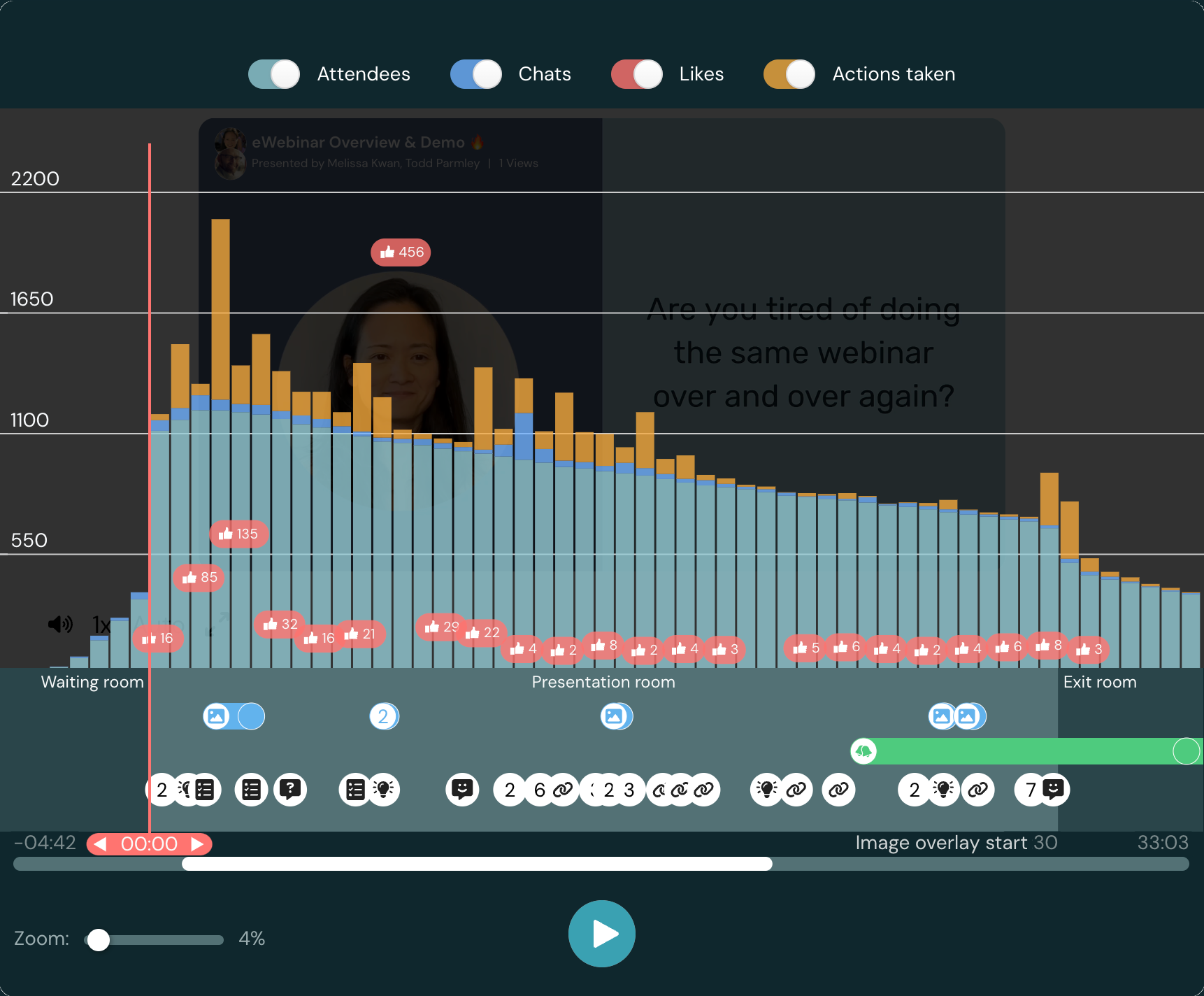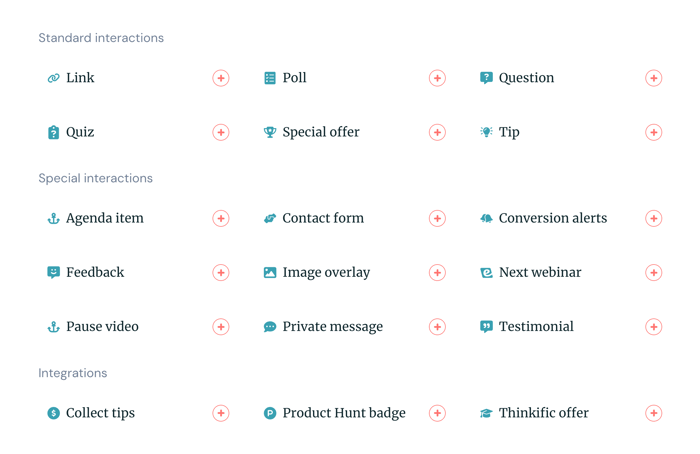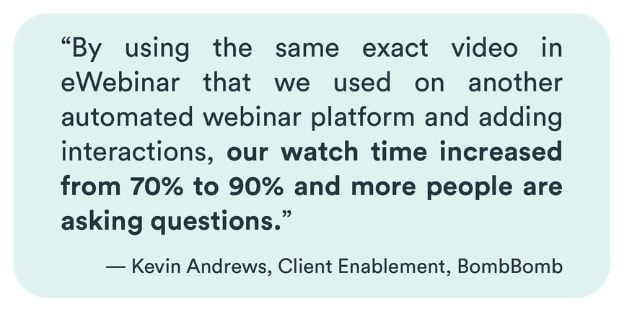Webinars that drag on too long do nothing but waste the host's time while boring attendees into leaving before the CTA rolls around. Conversely, presentations that are too short only cover information on a superficial level and therefore don't provide any unique value.
The key lies in finding that Goldilocks zone where attendees are most likely to convert.
In this guide, we'll go over how long a webinar should last, what to consider when deciding on presentation length, and how running pre-recorded webinars with automated interactions can get your attendees to stay longer.
Note: There are multiple automated webinar platforms you could consider but the examples in this guide will be in the context of our product, eWebinar, because that's the software we're most familiar with. If any mentioned features are exclusive to our platform, we'll let you know.
Let's dive in!
Does an optimal webinar length exist
Before we try to answer the question of how long a webinar should be, it's important to ask if an optimal length even exists.
If your content is engaging and manages to hold your audience's attention then it doesn't really matter how long the presentation is. In fact, MAGFAST has generated over $14 million with webinars that can last up to six hours.
On the other end of the spectrum, even a half-hour webinar won't convert if you tease a solution the entire time and then lock the answer behind a paywall at the end. Stringing attendees along with bait-and-switch tactics will do far more harm than increasing your presentation's runtime.
That said, an absurdly long runtime could reduce registration or attendance rates.
The answer to "How long is too long?" will vary depending on what you're covering. If the core presentation covers a lengthy topic then it's better to take ample time than rush through. If you're hosting webinars to generate sales then it becomes a question of how long you can keep attendees engaged.
Remember, compromising quality in favor of some arbitrary "perfect webinar length" will make the presentation shorter but less compelling. Similarly, skipping out on a question-and-answer session because you don't want to host webinars for more than one hour could make attendees feel neglected.
How long should a webinar last
While there's no hard and fast rule for the "best webinar length," 60 minutes is the most popular length according to data from Zippia. This consists of 5-7 minutes for welcoming attendees and introducing yourself, 38-45 minutes to present on the core topic, and 10-15 minutes for a Q&A.
Figuring out the best length for your webinar
Purpose, topic, and availability are the three factors to consider.
When trying to determine your ideal webinar length, there are a few things to consider:
-
Topic. What topic are you covering and how complex is it?
-
Purpose. What do your attendees hope to achieve by attending it?
-
Availability. How much time are you able to dedicate to your webinar sessions?
Topic
The more complicated the topic of your webinar is, the longer it will take to cover it fully. Some particularly complex topics also extend the length of presentations by virtue of attendee questions that must be answered.
Conversely, don’t artificially extend your webinar length with filler content if you’re covering a simple topic. There’s nothing wrong with giving attendees a straightforward answer quickly — doing the opposite is what could cost you your audience.
Purpose
When thinking about the purpose of your webinar, it's important to consider both sides:
-
Why you're hosting the webinar (generate leads, drive sales, etc.)
-
Why the attendee is watching the webinar (looking to solve a specific problem)
The ideal length will be however long it takes to fulfill both the goal of the host and the attendee.
If you jump straight to the CTA without solving the attendee's problem (or convincing them that you're capable of doing so) then they're unlikely to convert. On the other hand, spending too much time on the solution could end with the attendee leaving before you get to your call to action.
Creating webinars that offer mutual benefit will help you strike the right balance.
Availability
Of all these factors, availability will probably be the most limiting (if you're hosting live events). Most people don't have enough time to host long webinars on a regular basis — so be sure to choose a length that's sustainable for you.
If you choose to automate your webinar then this can alleviate the strain of hosting a long webinar live.
Our platform, eWebinar, lets you choose from three scheduling options:
-
On-demand. On-demand webinars can be accessed by potential customers at their peak moment of interest to increase the odds of them converting.
-
Recurring. Recurring webinars will automatically play at different times and days based on your settings or the time zone your attendee is in.
-
Replays. Replay links — which are automatically given to registrants — let attendees watch the presentation immediately with video player controls like play, pause, skip, etc.
You could also enable all three at once to maximize convenience for your webinar registrants.
Read our full guide on the 12 Best Automated Webinar Software Platforms to learn more!
How does webinar length affect engagement levels and watch time
If the length of your webinar exceeds the audience's attention span then attendees will leave early. Running webinars of a reasonable length can be subjective so it’s important to use data to find the point where attendees start leaving.
This screenshot from an automated webinar on eWebinar helps visualize how people drop off over time:

Live webinars are tricky in that there's not much you can do once you see attendees start dropping off (except haphazardly rushing toward the CTA before everyone is gone). However, if you're running pre-recorded webinars then you actually have the opportunity to make data-driven optimizations.
For instance, you could add automated interactions that pop up right before the drop-off points:

Making a webinar interactive will keep the audience engaged for the full length of your webinar. After all, attendees are more likely to stick around if they're able to participate by answering quizzes, voting on polls, and clicking on special offer popups.
Note: We're not the only webinar platform that lets you add automated interactions but most alternatives have two to five interaction types while we have 20+ — more than any other software, giving you more tools in your toolkit to keep the experience engaging.

Read the BombBomb case study →
How Long Should a Webinar Be: Final Verdict
It's clear that there's no one-size-fits-all "How long should a webinar be?" but you should always:
-
Make sure you fulfill both business goals and attendee problems with each webinar
-
Prioritize the quality of your presentation instead of focusing solely on the length
-
Keep attendees engaged longer by making your webinars interactive
If you want to offer long, more in-depth webinars to your audience but don't have the time to spend hours giving the same presentations over and over again then you should really consider on-demand webinars.
These will help you scale your availability essentially infinitely so you can offer recurring sessions at the most convenient time for each attendee — regardless of which time zone they're in. If you want to experience the eWebinar experience for yourself then watch our on-demand demo.










